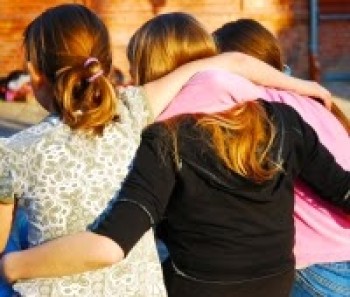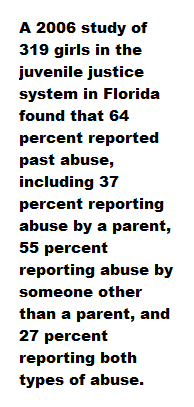Healing From Trauma: Girls in Juvenile Justice

Imagine being a child abused or neglected by someone you know, feeling unsafe in your own home, being betrayed by people who you should be able to trust. Where would you go? How would you cope with such traumatic experiences? For girls involved in the juvenile justice system, their options are very limited, and none of them would be seen as good choices from a middle class perspective. Girls typically turn their rage inward — they run away from home, are truant from schools, become defiant, or engage in self-harming behaviors. As a result, girls disproportionately end up in the juvenile justice system for status offenses—actions that would not be considered criminal if committed by adults—rather than for violent or person-to-person crimes.
In October, during the Office of Juvenile Justice and Delinquency Prevention’s National Girls Initiative Roundtable, a woman in her early thirties, who had been detained at the young age of 15, shared her story about the childhood experiences that led up to her involvement with the juvenile justice system. I sat still listening, moved by her strength and the courage it took to share the harsh realities of her childhood — a childhood marked by adverse experiences including sexual, physical and emotional abuse, neglect, and a lack of the kind of family support so many of us take for granted.
The reality is that her story of exposure to violence and family dysfunction is not uncommon. Through the 2012 pilot use of the Adverse Childhood Experiences (ACE) questionnaire in 18 Crittenton agencies across the country, we learned that of the nearly 200 juvenile justice-involved young women surveyed, 62 percent experienced 4 or more Adverse Childhood Experiences (abuse, family dysfunction and neglect). Compare this with the data for females in the original ACE study conducted by the Center for Disease Control and the Kaiser Foundation—where only 15 percent had experienced 4 or more Adverse Childhood Experiences—and the reality of how childhood adversity impacts the lives of girls and young women in the juvenile justice system comes into focus.
 The level of trauma experienced by girls now in the juvenile justice system is unacceptable. The challenge for the juvenile justice system is to accurately assess the context of girls’ lives in order to provide the programs and services they need and deserve to heal and thrive. Programs must be required to provide assessments and care that meet the unique needs of girls, and that are gender-appropriate, culturally-responsive and trauma-informed.
The level of trauma experienced by girls now in the juvenile justice system is unacceptable. The challenge for the juvenile justice system is to accurately assess the context of girls’ lives in order to provide the programs and services they need and deserve to heal and thrive. Programs must be required to provide assessments and care that meet the unique needs of girls, and that are gender-appropriate, culturally-responsive and trauma-informed.
Such programs would encompass, but are not limited to, girls being treated in the least restrictive environment (absence of handcuffs, shackling, etc.) whenever possible, placed in a facility that is in close proximity to the girls’ homes in order to maintain family relationships, consistent with female development that stress the role of relationships between staff members and girls, address the needs of parenting and pregnant teens, and are absent of triggers that could cause re-traumatization, etc. Girls programs need to be implemented in that it reflects on the understanding of the realities girls’ lives and addresses and responds to their individual strengths and challenges.
So what can you do to ensure that girls in the juvenile justice system get the support they need?
- Promote universal assessment for girls and boys involved in the juvenile justice system to better understand their exposure to violence, abuse and neglect.
- Advocate that girls in, or at risk of entering, the juvenile justice system receive gender and culturally-responsive, trauma-informed services to heal from the violence and abuse they have experienced.
- Push for the reauthorization of the Juvenile Justice Delinquency Prevention Act, with a focus on preventing detention for status offenses and the importance of gender-responsive and trauma-informed services.
- Endorse and advance the important work of organizations like the Coalition for Juvenile Justice and the National Standards for the Care of Youth Charged with Status Offenses.
As for the woman who shared her story, while she did not get the therapeutic services she needed through the juvenile justice system, through the course of her life she was able to get the appropriate services and support, and today continues her journey of healing. Despite it all, she is determined to keep her past from dictating her future.
______________________________________________________________________________
Jessie Domingo Salu started her career as a social worker in the late 1990's, where she supported girls and young women recognize their potential and achieve their goals in school and in-home settings. Today, she is the Vice President for The National Crittenton Foundation, the umbrella for the 27 members of the Crittenton family of agencies operating in 32 states and the District of Columbia providing a continuum of services to girls and young women in a variety of settings including in-home, residential, foster care, and community based to support girls and young women to heal and achieve their full potential.
 This post is part of the JJDPA Matters blog, a project of the Act4JJ Campaign with help from SparkAction.
This post is part of the JJDPA Matters blog, a project of the Act4JJ Campaign with help from SparkAction.
The JJDPA, the nation's landmark juvenile justice law, turned 40 in September 2014. To mark this anniversary, Act4JJ member organizations and allies will post blogs on issues related to the JJDPA throughout the fall and winter. To learn more and take action in support of JJDPA, visit the Act4JJ JJDPA Matters Action Center, powered by SparkAction.

